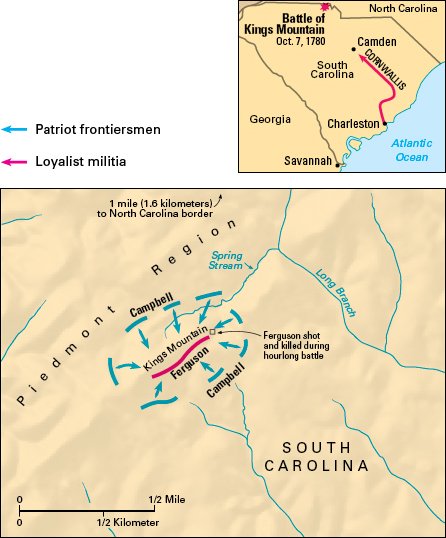Kings Mountain, Battle of, was an important patriot victory in the American Revolution (1775-1783). It was fought at Kings Mountain, South Carolina, in October 1780. Patriot troops led by Colonel William Campbell defeated a pro-British force led by Major Patrick Ferguson. The pro-British force consisted almost entirely of American Loyalists—that is, Americans who remained loyal to Britain. Ferguson was the only British combatant in the battle.
Background.
By late 1778, the British, with support from Loyalists, had begun to focus their war strategy on the South. That December, the British captured the key port of Savannah, Georgia. In August 1780, British Lieutenant General Lord Charles Cornwallis won a smashing victory at Camden, South Carolina. The victory temporarily secured British control over the state. Cornwallis’s success soon led him to act more boldly.
In September 1780, Cornwallis marched into North Carolina. In doing so, he left South Carolina before Loyalist forces had been able to gain firm control of the area. After Cornwallis’s departure, patriots in South Carolina made life difficult for Loyalists.
Colonists from the western frontier turned out in large numbers to fight for the patriot cause. In late September, these “over the mountain men” joined other patriot militias (citizen armies) in what is now eastern Tennessee.
Patriot forces converged on Ferguson’s trained Loyalist regulars and newly recruited militia in western South Carolina, near the North Carolina border. Cornwallis hoped that Ferguson would screen the left flank of the British advance by holding the Carolina backcountry. Ferguson retreated as the patriots advanced. He finally halted on October 6 to make a stand with his force of about 1,000 Loyalist troops on a wooded, rocky ridge known as Kings Mountain. Campbell’s patriot force numbered about 1,800 men. The patriot officers included Colonel John Sevier, who later became the first governor of the state of Tennessee.
The battle.
At about 3 p.m. on October 7, the patriot frontiersmen began to slip stealthily through the trees up the ridge toward the British position. The Loyalists fired upon the advancing enemy but did little to slow their advance. Several times, Ferguson directed his men, armed with bayonets, to charge down the slope. The bayonet charges temporarily halted the advance of the patriots. However, as the Loyalists came down the slope, they were exposed to patriot marksmen hiding behind rocks and trees. As a result, the Loyalists suffered many casualties, and the patriots were able to ascend the ridge.

The two sides engaged in close, bloody combat. American riflemen surrounded the Loyalist position, killing or wounding many soldiers. Ferguson himself was shot off his horse and killed. Captain Abraham de Peyster then took command of the Loyalists, but he soon surrendered his badly battered force.
The battle lasted only one hour. In that time, more than 300 Loyalists were killed or wounded. Patriot casualties numbered less than 100. The patriots also captured about 700 Loyalist militiamen.
Aftermath.
After the Battle of Kings Mountain, Cornwallis’s weakened army returned to South Carolina. In January 1781, patriot forces defeated another part of Cornwallis’s army at the Battle of Cowpens. Today, the Kings Mountain National Military Park stands at the battlefield site. The park is a unit of the National Park Service.
See also American Revolution ; Camden, Battle of ; Cowpens, Battle of .
